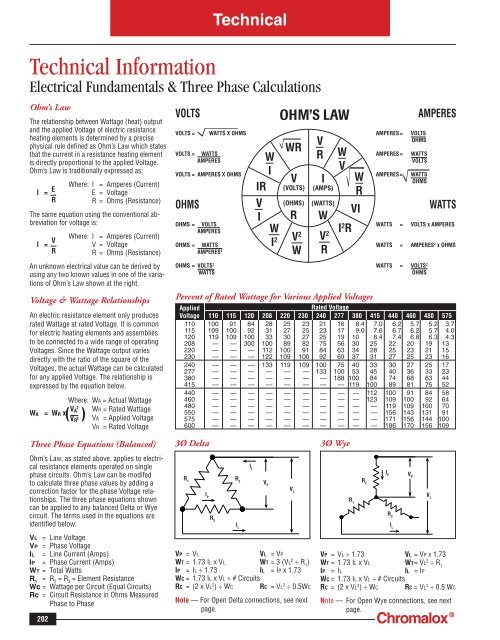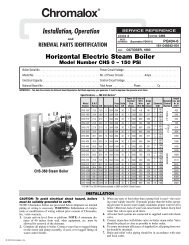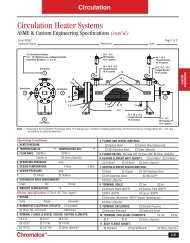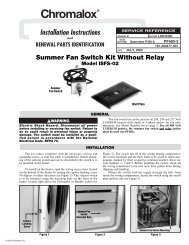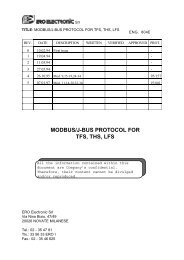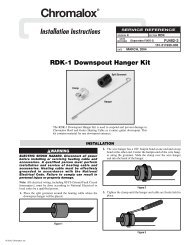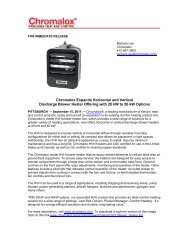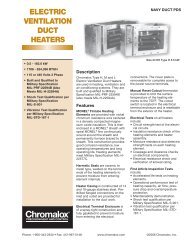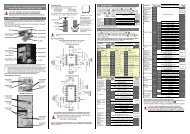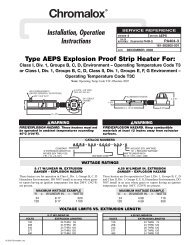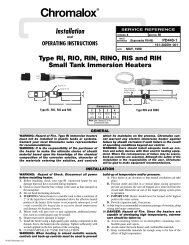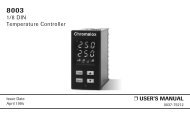Cold Weather Catalog - Chromalox Precision Heat and Control
Cold Weather Catalog - Chromalox Precision Heat and Control
Cold Weather Catalog - Chromalox Precision Heat and Control
- No tags were found...
You also want an ePaper? Increase the reach of your titles
YUMPU automatically turns print PDFs into web optimized ePapers that Google loves.
TechnicalTechnical InformationElectrical Fundamentals & Three Phase CalculationsOhm’s LawThe relationship between Wattage (heat) output<strong>and</strong> the applied Voltage of electric resistanceheating elements is determined by a precisephysical rule defi ned as Ohm’s Law which statesthat the current in a resistance heating elementis directly proportional to the applied Voltage.Ohm’s Law is traditionally expressed as:Where: I = Amperes (Current)I = EE = VoltageRR = Ohms (Resistance)The same equation using the conventional abbreviationfor voltage is:Where: I = Amperes (Current)I = VV = VoltageRR = Ohms (Resistance)An unknown electrical value can be derived byusing any two known values in one of the variationsof Ohm’s Law shown at the right.Voltage & Wattage RelationshipsAn electric resistance element only producesrated Wattage at rated Voltage. It is commonfor electric heating elements <strong>and</strong> assembliesto be connected to a wide range of operatingVoltages. Since the Wattage output variesdirectly with the ratio of the square of theVoltages, the actual Wattage can be calculatedfor any applied Voltage. The relationship isexpressed by the equation below,Where: WA = Actual Wattage2WR = Rated WattageWA = WR x V A( V R2 ) VA = Applied VoltageVR = Rated VoltageVOLTSVOLTS =VOLTS =WATTSAMPERESWATTS X OHMSVOLTS = AMPERES X OHMSOHMSOHMS =OHMS =VOLTSAMPERESWATTSAMPERES 2OHMS = VOLTS 2WATTSIRVIWIWI 2OHM’S LAWWRV(VOLTS)(OHMS)RV 2WVRI(AMPS)(WATTS)WPercent of Rated Wattage for Various Applied VoltagesAMPERES =AMPERES =AMPERES =AMPERESVOLTSOHMSWATTSVOLTSWATTSOHMSWATTSWATTS = VOLTS x AMPERESWATTS = AMPERES 2 x OHMSWATTS = VOLTS 2OHMSAppliedRated VoltageVoltage 110 115 120 208 220 230 240 277 380 415 440 460 480 575110 100 91 84 28 25 23 21 16 8.4 7.0 6.2 5.7 5.2 3.7115 109 100 92 31 27 25 23 17 9.0 7.6 6.7 6.2 5.7 4.0120 119 109 100 33 30 27 25 19 10 8.4 7.4 6.8 6.3 4.3208 — — 300 100 89 82 75 56 30 25 22 20 19 13220 — — — 112 100 91 84 63 34 28 25 23 21 15230 — — — 122 109 100 92 69 37 31 27 25 23 16240 — — — 133 119 109 100 75 40 33 30 27 25 17277 — — — — — — 133 100 53 45 40 36 33 23380 — — — — — — — 188 100 84 74 68 63 44415 — — — — — — — — 119 100 89 81 75 52440 — — — — — — — — — 112 100 91 84 58460 — — — — — — — — — 123 109 100 92 64480 — — — — — — — — — — 119 109 100 70550 — — — — — — — — — — 156 143 131 91575 — — — — — — — — — — 171 156 144 100600 — — — — — — — — — — 186 170 156 109V 2RWVI 2 RWRVIThree Phase Equations (Balanced)Ohm’s Law, as stated above, applies to electricalresistance elements operated on singlephase circuits. Ohm’s Law can be modifedto calculate three phase values by adding acorrection factor for the phase Voltage relationships.The three phase equations showncan be applied to any balanced Delta or Wyecircuit. The terms used in the equations areidentifi ed below:VL = Line VoltageVP = Phase VoltageIL = Line Current (Amps)IP = Phase Current (Amps)WT = Total WattsR 1= R 2= R 3= Element ResistanceWc = Wattage per Circuit (Equal Circuits)Rc = Circuit Resistance in Ohms MeasuredPhase to Phase2023Ø DeltaI LR R 1 2 R 2 R 1 V PI PV LR 3R 3I LI LVP = VLVL = VPWT = 1.73 IL x VL WT = 3 (VL 2 ÷ R 1)IP = IL ÷ 1.73 IL = IP x 1.73WC = 1.73 IL x VL ÷ # CircuitsRC = (2 x VL 2 ) ÷ WC RC = VL 2 ÷ 0.5WCNote — For Open Delta connections, see nextpage.3Ø WyeVP = VL ÷ 1.73 VL = VP X 1.73WT = 1.73 IL x VL WT = VL 2 ÷ R 1IP = ILI PIL = IPWC = 1.73 IL x VL ÷ # CircuitsRC = (2 x VL 2 ) ÷ WC RC = VL 2 ÷ 0.5 WCNote — For Open Wye connections, see nextpage.V PV L


